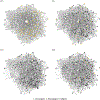Smoking Diffusion through Networks of Diverse, Urban American Adolescents over the High School Period
- PMID: 31526021
- PMCID: PMC7456568
- DOI: 10.1177/0022146519870521
Smoking Diffusion through Networks of Diverse, Urban American Adolescents over the High School Period
Abstract
This study uses recent data to investigate if smoking initiation diffuses through friendship networks over the high school period and explores if diffusion processes differ across schools. One thousand four hundred and twenty-five racially and ethnically diverse youth from four high schools in Los Angeles were surveyed four times over the high school period from 2010 to 2013. Probit regression models and stochastic actor-based models for network dynamics tested for peer effects on smoking initiation. Friend smoking was found to predict adolescent smoking, and smoking initiation diffused through friendship networks in some but not all of the schools. School differences in smoking rates and the popularity of smokers may be linked to differences in the diffusion of smoking through peer networks. We conclude that there are differences in peer effects on smoking initiation across schools that will be important to account for in network-based smoking interventions.
Keywords: adolescent; diffusion; high school; smoking initiation; social network; stochastic actor-based model.
Figures

Similar articles
-
Depressive Symptomology as a Moderator of Friend Selection and Influence on Substance Use Involvement: Estimates from Grades 6 to 12 in Six Longitudinal School-Based Social Networks.J Youth Adolesc. 2018 Nov;47(11):2337-2352. doi: 10.1007/s10964-018-0915-5. Epub 2018 Aug 16. J Youth Adolesc. 2018. PMID: 30117087
-
Simulating social network-based interventions for adolescent cigarette smoking.Soc Sci Med. 2025 Sep;380:118196. doi: 10.1016/j.socscimed.2025.118196. Epub 2025 May 15. Soc Sci Med. 2025. PMID: 40449410
-
Peers, schools, and adolescent cigarette smoking.J Adolesc Health. 2001 Jul;29(1):22-30. doi: 10.1016/s1054-139x(01)00210-5. J Adolesc Health. 2001. PMID: 11429302
-
The interdependence of cigarette, alcohol, and marijuana use in the context of school-based social networks.PLoS One. 2018 Jul 20;13(7):e0200904. doi: 10.1371/journal.pone.0200904. eCollection 2018. PLoS One. 2018. PMID: 30028843 Free PMC article.
-
Peer effects on adolescent smoking: Are popular teens more influential?PLoS One. 2018 Jul 12;13(7):e0189360. doi: 10.1371/journal.pone.0189360. eCollection 2018. PLoS One. 2018. PMID: 30001357 Free PMC article.
Cited by
-
Social Network Influences on Adolescent E-cigarette Use.Subst Use Misuse. 2023;58(6):780-786. doi: 10.1080/10826084.2023.2188429. Epub 2023 Mar 16. Subst Use Misuse. 2023. PMID: 36924165 Free PMC article.
-
Multilevel network interventions: Goals, actions, and outcomes.Soc Networks. 2023 Jan;72:108-120. doi: 10.1016/j.socnet.2022.09.005. Epub 2022 Sep 23. Soc Networks. 2023. PMID: 36188126 Free PMC article.
-
Peer and Social Correlates of Smoking among Saudi Youth.Socius. 2024 Jan-Dec;10:10.1177/23780231241286735. doi: 10.1177/23780231241286735. Epub 2024 Oct 15. Socius. 2024. PMID: 40535305 Free PMC article.
-
Social influence and advocacy pathways during a web-based program for adolescent smoking prevention.Addict Behav Rep. 2024 Jan 6;19:100529. doi: 10.1016/j.abrep.2024.100529. eCollection 2024 Jun. Addict Behav Rep. 2024. PMID: 38283066 Free PMC article.
References
-
- Alexander Cheryl, Piazza Marina, Mekos Debra, and Valente Thomas. 2001. “Peers, Schools, and Adolescent Cigarette Smoking.” Journal of Adolescent Health 29(1):22–30. - PubMed
-
- Campbell Rona, Starkey Fenella, Holliday Jo C., Audrey Suzanne, Bloor Michael J., Nina Parry-Langdon Rachael A. Hughes, and Moore Laurence. 2008. “An Informal School-Based Peer-Led Intervention for Smoking Prevention in Adolescence (Assist): A Cluster Randomised Trial.” Lancet 371(9624):1595–602. - PMC - PubMed
-
- Dijkstra Jan Kornelis, and Gest Scott D.. 2015. “Peer Norm Salience for Academic Achievement, Prosocial Behavior, and Bullying: Implications for Adolescent School Experiences.” The Journal of Early Adolescence 35(1):79–96.
Publication types
MeSH terms
Grants and funding
LinkOut - more resources
Full Text Sources
Medical

